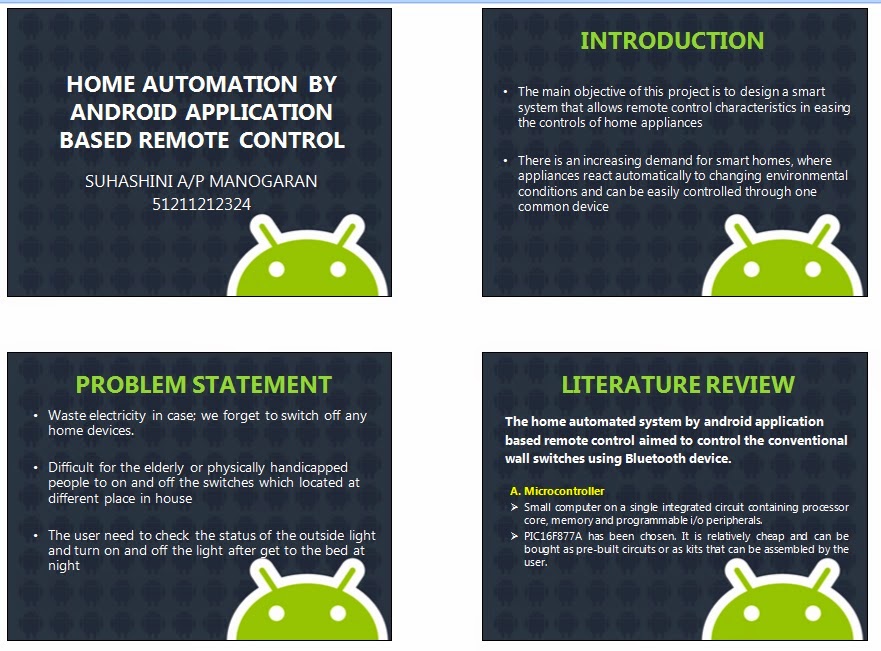PROBLEM STATEMENT
The main objective of this project is to design a home automation system
that allows remote control characteristics in easing the controls of home
appliances. Without this technology, user may face many problems in setting up
a Home Control System to control our home devices such as:
· Difficult for the elderly or physically handicapped
people to on and off the switches which located at different place in house.
· Waste our time in case; need
to wake up in night if we forget to switch off any devices that may be danger
to our house.
· Waste electricity in case;
forget to switch off any home devices at upstairs if double storey houses.
LITERATURE
REVIEW
Literature review is a short and precise
overview about the present state of research that is immediately connected with
the proposed project. It also focuses on various theory and basic knowledge
used in this project. In home automation, Android
application act as transmitter, which sends ON/OFF commands to the receiver
where loads are connected. By operating the specified remote switch on the
transmitter, the loads can be turned ON/OFF remotely through wireless technology.
Integration of Bluetooth and Wi-Fi
technology in Controlling home appliances can help and improve lifestyle of all
user groups especially to the disabled and elderly people in term of safety and
comfortable. The implementation of combined wired and wireless systems would be
of most practical in designing a smart home system especially in cutting the
system’s installation cost for conventional home.
A microcontroller is a small computer on
a single integrated circuit containing processor core,memory and programmable
I/O peripherals. [3] After much research, PIC16F877A has been
chosen. PIC microcontrollers (Programmable Interface Controllers) are
electronic circuits that can be programmed to carry out a vast range of tasks.
They can be programmed to be timers or to control a production line and much
more. PIC Microcontrollers are relatively cheap and can be bought as pre-built
circuits or as kits that can be assembled by the user. [3]
Software design
section includes the main functions of the system designed in the PIC
microcontroller and the GUIs Android application. The switches detection
function is performed by the microcontroller, PIC. Window GUI is designed by a
user-friendly interface. Control board ’’Connect‟ button is performed to
establish connection to main control board by Bluetooth or USB. Phone
‘’Connect‟ button is performed to establish connection between Window GUI and
Android GUI. When the both connections are established, Window GUI acts as the
server between main board and phone.
METHODOLOGY
In this project, the core
part to develop the home automated system is microcontroller. It acts as a
brain which controls the whole system. This project consists of input and an
output system. There are various methods involved in this project which
includes:
 Design a home automation
prototype with appropriate and precise height, weight and width.
Design a home automation
prototype with appropriate and precise height, weight and width.
 Design and construct circuit
which consists of control system and subsystems
Design and construct circuit
which consists of control system and subsystems
 Create programming code
using C language to be used with the PIC.
Create programming code
using C language to be used with the PIC.
 Assembly all the circuits
and build a home automation prototype.
Assembly all the circuits
and build a home automation prototype.
 Troubleshoot the circuit to
ensure the functionality of it.
Troubleshoot the circuit to
ensure the functionality of it.
A.BLOCK DIAGRAM
The hardware unit of the
prototype is represented by the block diagram above. It contains a PIC16F877A
microcontroller as the main processing unit and it gets inputs from the voltage
regulator, and Bluetooth device. From the data obtained from the Bluetooth
module the program controls the actuator components such as fans and fluorescent
light to achieve the system requirements.
B.FLOW CHART
Figure 2: Flowchart
OBJECTIVE
This
research study intends to plug the research gap and will demonstrate the
development of the home automation system with Android based remote control by:
•
To
study and research and design the home appliances and the control system
•
To
study and research about the wireless Bluetooth module
•
To study and research about the various
microcontroller architectures
•
To
learn about the android application software
•
To allow the
system to portray a two-way communication system between the house-hold
appliances and user’s controlling device






